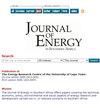Using normalised cross correlation and variance to determine the source of voltage unbalance exceedances in Eskom networks with wind farms
IF 0.6
4区 工程技术
Q4 ENERGY & FUELS
引用次数: 0
Abstract
During an exceedance of the voltage unbalance limit at a busbar there is a need to determine which entity is causing the problem between Eskom, wind farms and other entities that can influence the voltage unbalance at the busbar. There were voltage unbalance limit exceedances at Eskom-K, Eskom-C and Eskom-Z Eskom substations. There was a need to determine which entity was causing the voltage unbalance exceedances at these substations between Eskom, Transnet and wind farms. The normalised cross correlation was used to determine the source of voltage unbalance exceedances at Eskom-K and Eskom-C substation. The normal- ised cross correlation together with the variance was used to determine the source of voltage unbalance exceedances at Eskom-Z substation. The correlation value of Eskom-K voltage unbalance when correlated with the wind farm’s total active power was close to one. The correlation value of Eskom-C voltage unbalance when correlated with the Eskom loads was also close to one. There was a high variance of the voltage un- balance and corresponded to the high variance of the Transnet traction station loads. Based on the correlation and variance results, it was concluded that voltage unbalance at Eskom-K substation was caused by the wind farms. The voltage unbalance at Eskom-C substation was caused by the Eskom loads. The voltage unbalance at Eskom-Z was caused by the traction loads because the Eskom-Z voltage unbalance variance corresponded with the traction load variance.使用归一化的互相关和方差来确定Eskom风电场网络电压不平衡超标的来源
在母线电压不平衡超出限制时,需要确定是哪个实体造成了Eskom、风力发电场和其他可能影响母线电压不平衡的实体之间的问题。Eskom- k、Eskom- c和Eskom- z变电站电压不平衡极限超标。有必要确定是哪个实体造成了Eskom、Transnet和风电场之间这些变电站的电压不平衡超标。用归一化的相互关系来确定esom - k和esom - c变电站电压不平衡超标的来源。用正态化的相互关系和方差确定了Eskom-Z变电站电压不平衡超标的来源。Eskom-K电压不平衡与风电场总有功功率相关值接近于1。Eskom- c电压不平衡与Eskom负荷相关时的相关值也接近于1。电压不平衡变化较大,与输电网牵引站负荷变化较大相对应。根据相关分析和方差分析结果,认为Eskom-K变电站电压不平衡是由风电场引起的。Eskom- c变电站电压不平衡是由Eskom负荷引起的。由于eskomm - z电压不平衡的变化与牵引负荷的变化相对应,因此eskomm - z电压不平衡是由牵引负荷引起的。
本文章由计算机程序翻译,如有差异,请以英文原文为准。
求助全文
约1分钟内获得全文
求助全文
来源期刊

Journal of Energy in Southern Africa
ENERGY & FUELS-
CiteScore
3.00
自引率
0.00%
发文量
16
审稿时长
6 months
期刊介绍:
The journal has a regional focus on southern Africa. Manuscripts that are accepted for consideration to publish in the journal must address energy issues in southern Africa or have a clear component relevant to southern Africa, including research that was set-up or designed in the region. The southern African region is considered to be constituted by the following fifteen (15) countries: Angola, Botswana, Democratic Republic of Congo, Lesotho, Malawi, Madagascar, Mauritius, Mozambique, Namibia, Seychelles, South Africa, Swaziland, Tanzania, Zambia and Zimbabwe.
Within this broad field of energy research, topics of particular interest include energy efficiency, modelling, renewable energy, poverty, sustainable development, climate change mitigation, energy security, energy policy, energy governance, markets, technology and innovation.
 求助内容:
求助内容: 应助结果提醒方式:
应助结果提醒方式:


